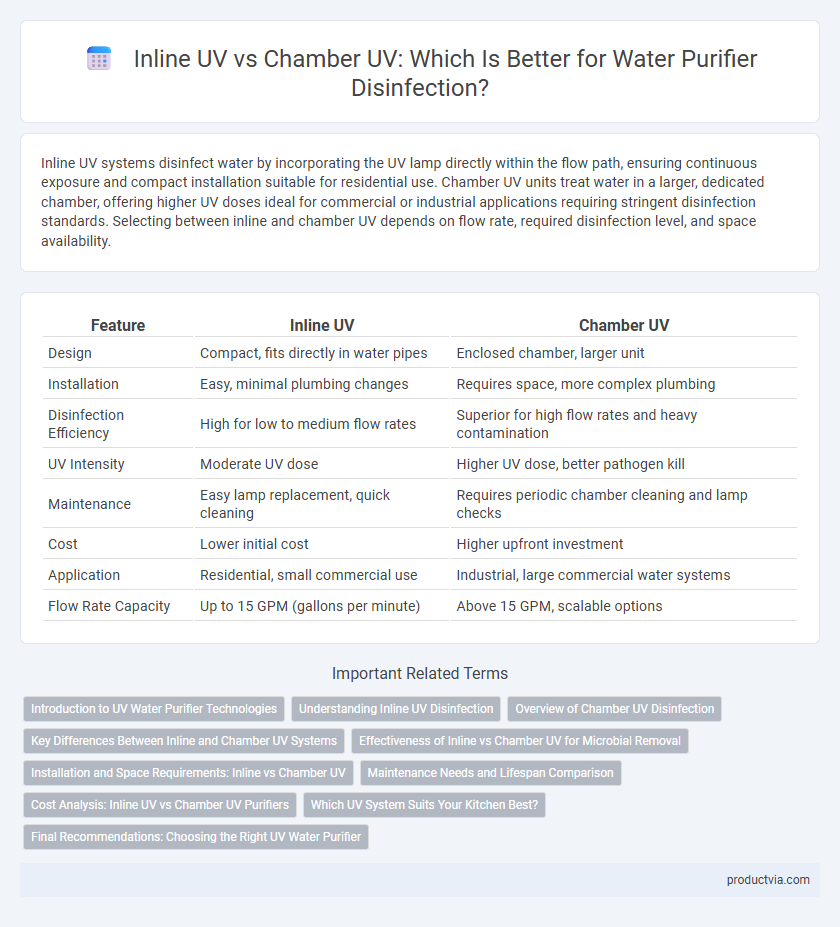Inline UV systems disinfect water by incorporating the UV lamp directly within the flow path, ensuring continuous exposure and compact installation suitable for residential use. Chamber UV units treat water in a larger, dedicated chamber, offering higher UV doses ideal for commercial or industrial applications requiring stringent disinfection standards. Selecting between inline and chamber UV depends on flow rate, required disinfection level, and space availability.
Table of Comparison
| Feature | Inline UV | Chamber UV |
|---|---|---|
| Design | Compact, fits directly in water pipes | Enclosed chamber, larger unit |
| Installation | Easy, minimal plumbing changes | Requires space, more complex plumbing |
| Disinfection Efficiency | High for low to medium flow rates | Superior for high flow rates and heavy contamination |
| UV Intensity | Moderate UV dose | Higher UV dose, better pathogen kill |
| Maintenance | Easy lamp replacement, quick cleaning | Requires periodic chamber cleaning and lamp checks |
| Cost | Lower initial cost | Higher upfront investment |
| Application | Residential, small commercial use | Industrial, large commercial water systems |
| Flow Rate Capacity | Up to 15 GPM (gallons per minute) | Above 15 GPM, scalable options |
Introduction to UV Water Purifier Technologies
Inline UV water purifiers feature a compact design where water flows directly through a UV-irradiated quartz sleeve, ensuring rapid and effective disinfection within pipelines. Chamber UV systems utilize a larger UV light chamber allowing prolonged exposure time, which enhances microbial inactivation for high-flow or variable pressure applications. Both technologies rely on ultraviolet light at 254 nm wavelength to destroy DNA and RNA of pathogens, providing chemical-free and energy-efficient water purification.
Understanding Inline UV Disinfection
Inline UV disinfection systems treat water by passing it through a sealed chamber where UV lamps emit germicidal radiation, effectively inactivating bacteria, viruses, and protozoa. Unlike chamber UV systems that require large holding tanks, inline UV units operate directly within the pipeline, ensuring continuous, real-time disinfection without disrupting flow rates. This design enhances efficiency in residential and commercial water purifiers by delivering consistent pathogen control with minimal maintenance.
Overview of Chamber UV Disinfection
Chamber UV disinfection employs a dedicated reactor chamber where water passes through a controlled UV environment, ensuring consistent exposure to germicidal UV-C light for effective microbial inactivation. This method allows precise control over contact time and UV intensity, optimizing the disinfection process for various flow rates and water qualities. Chamber UV systems are favored in applications requiring high disinfection reliability and minimal maintenance, offering improved pathogen reduction compared to other UV setups.
Key Differences Between Inline and Chamber UV Systems
Inline UV systems integrate directly into water pipelines, providing continuous disinfection with compact design and simpler installation, ideal for residential or small-scale use. Chamber UV systems utilize a larger treatment chamber, allowing for longer water exposure to UV rays and higher flow rates, making them suitable for industrial or high-demand applications. The key differences lie in flow capacity, installation complexity, and exposure time, affecting overall disinfection efficiency and maintenance requirements.
Effectiveness of Inline vs Chamber UV for Microbial Removal
Inline UV systems deliver UV light directly within the water flow, ensuring consistent exposure and effective inactivation of bacteria, viruses, and protozoa. Chamber UV systems utilize a larger reaction chamber that provides extended contact time and enhanced microbial removal, especially in high-turbidity water. Studies indicate that chamber UV often achieves higher log reduction values for resistant pathogens due to prolonged UV exposure, while inline UV offers compact design and efficient, rapid disinfection.
Installation and Space Requirements: Inline vs Chamber UV
Inline UV systems offer compact installation with minimal space requirements, making them ideal for households or setups with limited room. Chamber UV units require larger, dedicated space due to their bulkier design and need for precise placement within plumbing systems. Choosing between inline and chamber UV depends on available installation space and the complexity of integrating the system into existing water lines.
Maintenance Needs and Lifespan Comparison
Inline UV water purifiers typically require less frequent maintenance due to their streamlined design that minimizes sediment buildup, extending lamp and sleeve lifespan compared to chamber UV systems. Chamber UV units often need regular cleaning and more intensive monitoring to prevent fouling inside the disinfection chamber, which can shorten the effectiveness of the UV lamp and decrease overall system longevity. Choosing an inline UV system can optimize maintenance intervals and maximize operational lifespan, reducing long-term servicing costs.
Cost Analysis: Inline UV vs Chamber UV Purifiers
Inline UV purifiers typically have a lower initial cost and reduced maintenance expenses compared to chamber UV systems, making them a cost-effective choice for residential use. Chamber UV purifiers often require higher upfront investment due to larger reactors and more complex installation, but they provide greater disinfection capacity ideal for commercial applications. Evaluating total cost of ownership for Inline UV versus Chamber UV should include factors such as energy consumption, lamp replacement frequency, and system lifespan to determine optimal value.
Which UV System Suits Your Kitchen Best?
Inline UV systems offer continuous water flow disinfection, ideal for kitchens requiring fast, high-volume purification without storage. Chamber UV units provide targeted, high-intensity treatment within a controlled space, making them suitable for smaller kitchens or point-of-use applications. Choosing the right UV system depends on your water usage, space availability, and desired disinfection efficiency in your kitchen setup.
Final Recommendations: Choosing the Right UV Water Purifier
Inline UV systems offer continuous, high-flow disinfection ideal for whole-house water purification, while Chamber UV units provide targeted treatment with enhanced exposure time for point-of-use applications. For households prioritizing comprehensive water safety with consistent flow rates, Inline UV purifiers maximize pathogen removal efficiency. In contrast, Chamber UV purifiers are optimal for small, specific outlets requiring intensive microbial control and ease of maintenance.
Inline UV vs Chamber UV for disinfection Infographic

 productvia.com
productvia.com